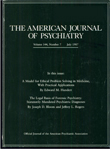DSM-IV Substance Use Disorder Criteria for Adolescents: A Critical Examination Based on a Statewide School Survey
Abstract
OBJECTIVE: The DSM-IV criteria for substance use disorders were incorporated into the 1995 Minnesota Student Survey in order to estimate the need for alcohol/drug treatment among adolescents in the state. This study used data from the survey to examine the utility of individual diagnostic criterion items, diagnostic categories, and diagnostic thresholds in a general adolescent population. METHOD: The survey was administered to ninth- and 12th-grade public school students. Participation was voluntary, and survey questionnaires were anonymous. The survey included questions about the use of substances during the past year and the presence of DSM-IV criterion symptoms for substance abuse and dependence. This study was based on responses from 74,008 students who answered these questions. RESULTS: Of the students who reported any substance use in the past 12 months, 13.8% of the ninth graders and 22.7% of the 12th graders met the criteria for a substance abuse diagnosis, and 8.2% of the ninth graders and 10.5% of the 12th graders met the criteria for dependence. The presence of multiple criterion symptoms was strongly associated with the use of multiple drugs. Analyses of positive and negative predictive value, sensitivity, and specificity did not support the diagnostic distinction between dependence criteria and abuse criteria. CONCLUSIONS: A combined set of criteria, with empirically derived diagnostic threshold categories based on total number of symptoms, may be more suitable for estimates of substance use disorders and need for treatment among adolescents.



